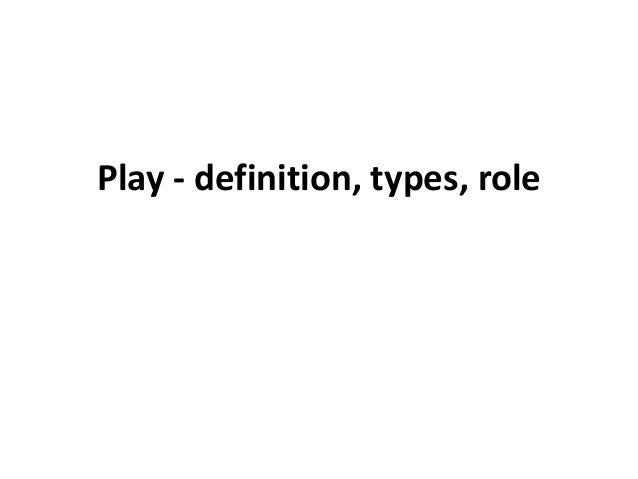Play - definition, types, role.pptx
•Download as PPTX, PDF•
0 likes•2 views
Brief description of play from Lifespan Perspective
Report
Share
Report
Share

Recommended
Recommended
More than Just Lines on a Map: Best Practices for U.S Bike Routes
This session highlights best practices and lessons learned for U.S. Bike Route System designation, as well as how and why these routes should be integrated into bicycle planning at the local and regional level.
Presenters:
Presenter: Kevin Luecke Toole Design Group
Co-Presenter: Virginia Sullivan Adventure Cycling AssociationMore than Just Lines on a Map: Best Practices for U.S Bike Routes

More than Just Lines on a Map: Best Practices for U.S Bike RoutesProject for Public Spaces & National Center for Biking and Walking
More Related Content
Featured
More than Just Lines on a Map: Best Practices for U.S Bike Routes
This session highlights best practices and lessons learned for U.S. Bike Route System designation, as well as how and why these routes should be integrated into bicycle planning at the local and regional level.
Presenters:
Presenter: Kevin Luecke Toole Design Group
Co-Presenter: Virginia Sullivan Adventure Cycling AssociationMore than Just Lines on a Map: Best Practices for U.S Bike Routes

More than Just Lines on a Map: Best Practices for U.S Bike RoutesProject for Public Spaces & National Center for Biking and Walking
Featured (20)
Content Methodology: A Best Practices Report (Webinar)

Content Methodology: A Best Practices Report (Webinar)
How to Prepare For a Successful Job Search for 2024

How to Prepare For a Successful Job Search for 2024
Social Media Marketing Trends 2024 // The Global Indie Insights

Social Media Marketing Trends 2024 // The Global Indie Insights
Trends In Paid Search: Navigating The Digital Landscape In 2024

Trends In Paid Search: Navigating The Digital Landscape In 2024
5 Public speaking tips from TED - Visualized summary

5 Public speaking tips from TED - Visualized summary
Google's Just Not That Into You: Understanding Core Updates & Search Intent

Google's Just Not That Into You: Understanding Core Updates & Search Intent
The six step guide to practical project management

The six step guide to practical project management
Beginners Guide to TikTok for Search - Rachel Pearson - We are Tilt __ Bright...

Beginners Guide to TikTok for Search - Rachel Pearson - We are Tilt __ Bright...
Unlocking the Power of ChatGPT and AI in Testing - A Real-World Look, present...

Unlocking the Power of ChatGPT and AI in Testing - A Real-World Look, present...
More than Just Lines on a Map: Best Practices for U.S Bike Routes

More than Just Lines on a Map: Best Practices for U.S Bike Routes
Ride the Storm: Navigating Through Unstable Periods / Katerina Rudko (Belka G...

Ride the Storm: Navigating Through Unstable Periods / Katerina Rudko (Belka G...
Play - definition, types, role.pptx
- 1. Play - definition, types, role
- 2. PLAY ● According to Freud and Erikson, play helps the child master anxieties and reduce conflicts (Demanachick, 2015). ● Play therapy used to make children feel less threatened and be more likely to express their true feelings(Clark,2015, 2016; Demanachick, 2015; Yanof, 2013). ● Piaget (1962) maintained that play advances children’s cognitive development. ● Vygotsky (1962) highlighted symbolic and make-believe aspect of play which advances creative thought and cognitive development. ● Daniel Berlyne (1960) described play as exciting and pleasurable in itself because it satisfies our exploratory drive. ● Play enhances language development and communication skills (Christie & Roskos, 2015; Hirsh-Pasek & Golinkoff, 2014).
- 3. TYPES OF PLAY ●Sensorimotor play is behavior by infants to derive pleasure from exercising their sensorimotor schemes - second quarter of the first year of life. ●Practice play involves repetition of behavior when new skills are being learned or when physical or mental mastery and coordination of skills are required for games or sports - throughout life. ● Pretense/symbolic play occurs when the child transforms aspects of the physical environment into symbols - increased between 9 and 30 months of age. Catherine Garvey (2000) and Angeline Lillard (2006, 2015) emphasize that hidden in young children’s pretend play narratives are capacities for role taking of social roles, metacognition (thinking about thinking), testing of the reality-pretense distinction, and numerous nonegocentric capacities that reveal the remarkable cognitive skills of young children.
- 4. TYPES OF PLAY ● Social play involves interaction with peers - increases dramatically during the preschool years. Social play includes turn taking, conversations about numerous topics, social games and routines, and physical play (Sumaroka & Bornstein, 2008). Social play often involves a high degree of pleasure on the part of the participants (Sumaroka & Bornstein, 2008). ●Constructive play combines sensorimotor/practice play with symbolic representation. Constructive play occurs when children engage in the self-regulated creation of a product or a solution - frequent in elementary school years ●Games are activities that are engaged in for pleasure and have rules - reciprocity and taking turns. Often they involve competition.
- 5. WHAT ARE THE FUNCTIONS OF PLAY IN AN INDIVIDUAL’S LIFE? Singer, Golinkoff, and Hirsh-Pasek’s (2006) first book on play was titled: Play = Learning. •Among the cognitive benefits of play they described are these skills: creative, abstract thinking; imagination; attention, concentration, and persistence; problem-solving; social cognition, empathy, and perspective taking; language; and mastering new concepts. •Among the socio-emotional experiences and development they believe play promotes are enjoyment, relaxation, and self-expression; cooperation, sharing, and turn-taking; anxiety reduction; and self-confidence. •With so many positive cognitive and socio-emotional outcomes of play, clearly it is important that we find more time for play in young children’s lives (Bruce & others, 2017; Dyson, 2015; Lillard, 2015; Robson, 2017).